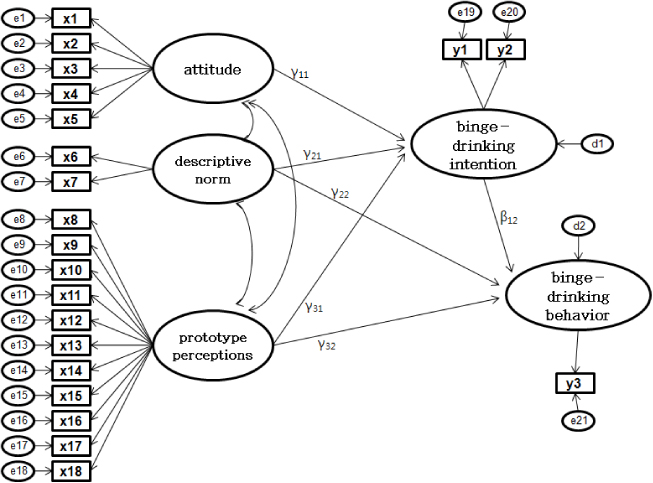College of Nursing, Catholic University of Pusan, Busan, Korea.
© 2014 Korean Society of Adult Nursing

AUDIT=alcohol use disorders identification test; χ2=chi square; dF=degree of freedom; GFI=goodness fit index; AGFI=adjusted goodness of fit index; RMSEA=root-mean square error of approximation; CFI=comparative fit index; NFI=normed fit index; NNFI=nonnormed fit index; SRMR=standardized root mean square residual; PNFI=parsimonious normed of fit index.

AUDIT=alcohol use disorders identification test; SMC=squared multiple correlation; DN=descriptive norm; PP=prototype perceptions; γ11=attitude→binge-drinking intetntion; γ13=attitude→binge-drinking intetntion→binge-drinking; γ21=descriptive norm→binge-drinking intetntion; γ22=descriptive norm→binge-drinking; γ31=prototype perceptions→binge-drinking intetntion; γ32=prototype perceptions→binge-drinking; β12=binge-drinking intetntion→binge-drinking.



Descriptive Statistics and Coefficient Correlations of Variables (N=223)
AUDIt=alcohol use disorders identification test; DN=descriptive norm; Pp=prototype perceptions; BD=binge-drinking.
*Correlation is significant at the .05 level (2~tailed); **Correlation is significant at the .01 level (2~tailed).
Comparison of Fitness of Statistics for the Modified Model (N=223)
AUDIT=alcohol use disorders identification test; χ2=chi square; dF=degree of freedom; GFI=goodness fit index; AGFI=adjusted goodness of fit index; RMSEA=root-mean square error of approximation; CFI=comparative fit index; NFI=normed fit index; NNFI=nonnormed fit index; SRMR=standardized root mean square residual; PNFI=parsimonious normed of fit index.
Parameter Estimates for Modified Model and Standardized Direct, Indirect, and Total Effects (N=223)
AUDIT=alcohol use disorders identification test; SMC=squared multiple correlation; DN=descriptive norm; PP=prototype perceptions; γ11=attitude→binge-drinking intetntion; γ13=attitude→binge-drinking intetntion→binge-drinking; γ21=descriptive norm→binge-drinking intetntion; γ22=descriptive norm→binge-drinking; γ31=prototype perceptions→binge-drinking intetntion; γ32=prototype perceptions→binge-drinking; β12=binge-drinking intetntion→binge-drinking.
AUDIt=alcohol use disorders identification test; DN=descriptive norm; Pp=prototype perceptions; BD=binge-drinking. *Correlation is significant at the .05 level (2~tailed); **Correlation is significant at the .01 level (2~tailed).
AUDIT=alcohol use disorders identification test; χ2=chi square; dF=degree of freedom; GFI=goodness fit index; AGFI=adjusted goodness of fit index; RMSEA=root-mean square error of approximation; CFI=comparative fit index; NFI=normed fit index; NNFI=nonnormed fit index; SRMR=standardized root mean square residual; PNFI=parsimonious normed of fit index.
AUDIT=alcohol use disorders identification test; SMC=squared multiple correlation; DN=descriptive norm; PP=prototype perceptions; γ11=attitude→binge-drinking intetntion; γ13=attitude→binge-drinking intetntion→binge-drinking; γ21=descriptive norm→binge-drinking intetntion; γ22=descriptive norm→binge-drinking; γ31=prototype perceptions→binge-drinking intetntion; γ32=prototype perceptions→binge-drinking; β12=binge-drinking intetntion→binge-drinking.